Mercedosaurus Rex at Indianapolic Park
Part 21: PC23's further active career after 1994
Author
- Henri Greuter
Date
- April 29, 2010
Related articles
- March-Alfa Romeo 90CA - Fiasco Italo-Brittanico, by Henri Greuter
- March-Porsche 90P - The last oddball at the Indianapolis Motor Speedway, by Henri Greuter
- Penske-Mercedes PC23-500I - Mercedosaurus Rex at Indianapolic Park, by Henri Greuter
- Introduction
- Part 1: Penske Racing at Indianapolis - new standards
- Part 2: Ilmor Engineering at Indianapolis
- Part 3: Mercedes, Benz and Mercedes-Benz at Indianapolis up until 1993
- Part 4: Equivalency formulas - waiting for things to go wrong
- Part 5: Stock blocks - keeping them rolling and promoting 'Born in the USA' technology
- Part 6: Indianapolis 1991 - Chevy And Rich Team owners
- Part 7: The Speedway narrowed, its speeds lowered
- Part 8: The forerunner
- Part 9: Pre-May '94 plans
- Part 10: Penske PC23 - a home for the engine
- Part 11: The 1994 Indycar season until mid-April
- Part 12: The unfair advantage and when others have it
- Part 13: Practice during the 1994 'Month of May'
- Part 14: Other bespoke-design 209s
- Part 15: From the last weekend of May '94 to the end of the season
- Part 16: Could the Mercedes Benz 500I have been stopped in time?
- Part 17: Creating an extinct species without it being forbidden, initially at least
- Part 18: The 1995 '500' - Did the Mercedosaurus bite its masters after all?
- Part 19: A possible twist of fate for Rahal-Hogan and Penske as a legacy of the 500I
- Part 20: Re-evaluation of our verdict
- Part 22: USAC’s points of views and some answers
- Part 23: The loose ends that didn’t fit in anywhere else and the epilogue
- Part 24: "Plan your work; work your plan" - Chuck Sprague on the PC23
- Appendix 1: Specifications
- Appendix 2: Car and driver appearances and performances during the Month of May 1994
- Appendix 3: Chassis, entry, practice and race numbers in 1994
- Appendix 4: PC23's 1994 results sans Mercedes Benz 500I
- Appendix 5: PC23's 1995-'96 results sans Mercedes Benz 500I
- Appendix 6: A reflection on the PC23 chassis used by Team Penske in 1994
- Appendix 7: A review of Beast by Jade Gurss
Who?Gary Bettenhausen What?Bettenhausen Penske-Mercedes PC23 Where?Michigan When?1996 US 500 |
 |
Why?
To properly conclude the story of the Penske PC23, here is an overview of what happened to the cars once the factory team discarded them.
Although no longer used by the factory, the PC23 kept on racing for one more year. Two cars fitted with the regular Mercedes-Benz IC108 engine were sold off to Bettenhausen Racing for Stefan Johansson to drive. Johansson’s best result was a third place at Nazareth, the race before the Penske Indianapolis Disaster. A fourth, fifth and sixth followed later on in the season.
Out of 17 races, Johansson raced the car 15 times, scored points in eight races with his year-old car and finished a creditable 13th place in the final classification. The races in which he didn’t use a PC23 were Indianapolis and Milwaukee.
At Indianapolis, like the factory team, Johansson couldn’t make either of his Penske chassis work decently. Early in the second week of practice, Bettenhausen Racing acquired a ’94 Reynard-Ford 94I from Arciero-Wells Racing. Funnily enough, the Reynard never matched the hottest laps Johansson turned with the Penskes. Nevertheless, Johansson did qualify the Reynard for the race in the drama-filled Bump Day that year which saw the Penske team take center stage in a way few ever believed they would see. Stefan qualified his Reynard on his third and last attempt. When he made the field he burst the bubble of none other than Emerson Fittipaldi, the lone Team Penske driver who had managed to make the field in a hired Lola-Mercedes.
Johansson didn’t race a PC23 at Milwaukee, a week after Indianapolis, either. He contested that race in a PC22-Mercedes, one of the cars he used during the 1994 season.
The Bettenhausen team had also planned to eschew the PC23 for one other race in 1995, using the PC22 again for the Michigan 500. When the gearbox of the PC22 broke early on in practice, the team had to use the PC23 after all. As if to underline the statement that a decent car at Michigan doesn’t necessarily mean it will be good at Indianapolis as well, Johansson didn’t qualify very well but brought the car which had let him down at Indianapolis almost 2.5 months earlier home in sixth place, one of the better scores of the year for the team.
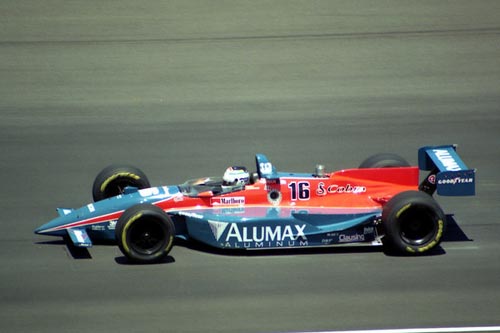
Stefan Johansson with the Bettenhausen Racing PC23-Mercedes IC108C at the daunting Michigan International Speedway. Note that the car carried its 'Novi' fin at the back. It ran without the fin at Indianapolis. At a track at least as fast as the Indianapolis Motor Speedway, courtesy of its banking, the PC23 behaved good enough to finish sixth. However: at Michigan there was no qualifying hurdle to take because of more cars being entered than that there were starting spots… (photo by Mark Windecker, used with permission)

Johansson in the PC23 on the road course of Mid-Ohio, a race ending in retirement because of engine problems. (photo by Mark Windecker, used with permission)
During the season, Johansson also suffered from the fact that that year's Goodyear tyres didn’t suit the Penske chassis. Nevertheless, Johansson’s efforts with the PC23, one year after its utterly dominant performance as a factory car, confirmed the fact that it was a milestone design in the history of CART racing.
The final outing for a PC23 in a CART event was a bit ironic. On Memorial Day 1996, a PC23 was once again competing in a 500-miles race. But not the one at Indianapolis…
The split between CART and IRL, which was foreseen in 1994, actually happened at the end of 1995 and the Indianapolis race became part of the newly created Indy Racing League. The confrontation between CART and IRL went so far that even though CART teams were theoretically welcome to participate in the 500-mile race, it would be on terms they felt unacceptable. CART then boycotted the Indianapolis event and organized its own 500-mile race for Memorial Day, the so called “U.S. 500” held at the Michigan Superspeedway.
Bettenhausen Racing had retired their Penskes and during 1996 used Reynard chassis for their driver Stefan Johansson. But team owner Tony Bettenhausen enabled his elder brother Gary to participate in the U.S. 500 with one of the Penske PC23 cars he still had. A Mercedes Benz IC108B engine was installed, replacing an IC108C. Although Gary was the slowest qualifier for the event, he still qualified in an unusual manner. Four warm-up laps were allowed preceding the two hot laps of which the fastest time would count for the grid. Gary only took three warm-up laps. His fourth lap was a lowly 208.607 and then the engine blew, making it impossible to finish a second qualifying lap: his first lap time had to do. But with only 27 cars around, almost any time would have been enough to make the field. Gary stated he could have been faster but pop-off valve problems forced him to qualify and take whatever the car was willing to do.
Gary avoided a massive crash that involved several cars prior to the start of the race, but after the restart he crashed out of the race in lap 89, good for 21st place. Up to the moment of the crash, Bettenhausen had driven a fastest lap of 217.39mph and stayed out of the way of the leaders. His strategy had been to keep out of trouble and if the car didn’t break prematurely to be there at the end on sheer stamina and hopefully end up high after all. The reason for the crash was the right rear tyre going flat.
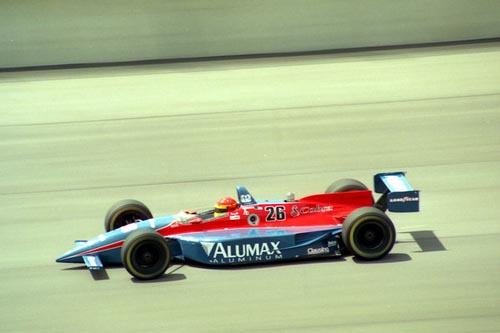
Gary Bettenhausen during the US500 in the Penske PC23 that his brother Tony had fielded a year ago for Stefan Johansson. This was the last-ever occasion that a PC23 was on active duty. Do you recognize Gary’s helmet? (photo by Mark Windecker, used with permission)
And that was, at long last, the end of the career for the Penske type PC23 in active racing. It was perhaps a bit of an anonymous ending, almost two years to the day after it had written racing history.
Two years earlier, the Penske PC23-Mercedes Benz 500I had been exclusive to Roger Penske’s team. For a number of people who opposed CART and supported the principles of the IRL, the PC23-500I was a perfect example of what was wrong with Indycar racing, and it fed their need to separate Indianapolis from CART. Now, with the split completed, here was one part of that combination taking part in its final public appearance in competition on a race track in, of all things, a 500-mile showcase event from a rival series…
Some public appearances of PC23s after their active careers
After 1996, the PC23s were only seen as show cars on display and occasionally at race car meetings as well.
For example, Mercedes had a big stand on the Dutch racing car show Speed & Design, held in early December 1996. One of the cars on display at the stand was a PC23-500I show car. I could not find out if it was the real car that is owned by the Mercedes Museum but the bodywork was indeed that of the ’94 Penske factory cars at Indianapolis.
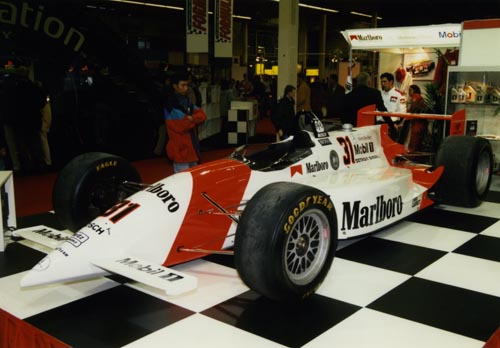
Real car or show car? At least something that looked like the winning car of the “500” in 1994 was on display on a Dutch motor car show at the end of 1996. I think that nobody else but me got back so many memories by seeing this.
(photo HG)
One of the cars, with a Mercedes 500I engine, was driven at the 2004 Goodwood Festival of Speed.
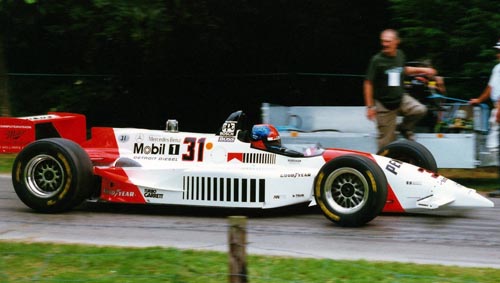
Emerson Fittipaldi, reunited with the car in which he drove his last ever “500” at Indianapolis and spun out while leading. This is Emmo’s actual chassis, entered in 1994 as #2, donated by Team Penske to the Mercedes Museum and repainted in the trim of the winning sister car. (photo copyright by Anthony Fosh, used with permission)
Even as late as 2009, PC23 show cars show up once in a while, sometimes at entirely unexpected places. Mr George Hatcher from Merritt Island, Florida ran into a Penske PC23 show car that was on display at an insurance company’s office in his hometown. He took the following pictures with his cell phone camera and put them on his Flickr webpage. They are reproduced here with his kind permission. The pictures were taken on June 19th, 2009. I also include the picture George took from the info board put up with the car. For those who know more about the PC23 cars and the 500I engine (and I hope that you have learned about them thanks to these pages), have fun with the provided info.
There is however no prize offered for the right answer for the following question: after identifying the car, how many errors does this info board contain?


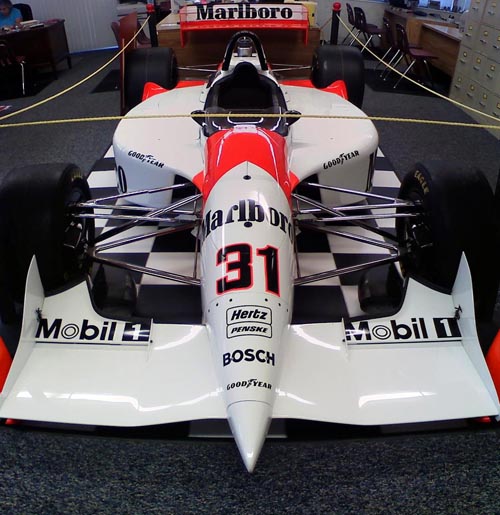
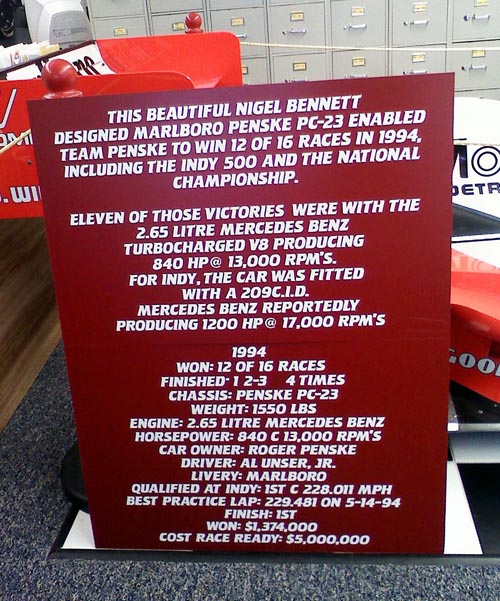
On display at Merritt Island in Florida in June 2009: a Penske PC23-Ilmor/D in the colours as driven by Al Unser Jr. In other words: the car of the CART champion that year. Genuine and complete or show car only? Never mind. Who would expect a car like this in the office of an insurance company?
(all pictures copyright George W. Hatcher, used with permission)
Known current locations of PC23 chassis
Right now (late April 2010) it is still unknown to me if there were eight or nine chassis of type PC23 built and what happened to the cars after their retirement. Of the following cars is known where they ended up:
PC23-003
Fittipaldi’s race car at Indianapolis, fitted with a 500I engine and repainted as the #31 winning sister car of Al Unser Jr., donated to the Mercedes Museum, in running condition.
PC23-007
Al Unser Jr’s winning car at Indianapolis, in the Penske collection, restored to Race Day 1994 condition.
PC23-008
Reported to be in private hands linked to the Penske organisation.
Returns in the spotlights in the theatre that made them famous
Being a “500” winner alone makes PC23-007 a special car among all surviving Indycars, even without the story of its engine used while winning the “500”. It would have been a more than welcome addition for permanent display at the Indianapolis Motor Speedway Museum. Instead, it is on display at the Penske Museum but it hasn't been on permanent display over there ever since. There have been periods in which the car was on loan, acting as a guest of honour elsewhere, as since 2011, the Indianapolis Motor Speedway Museum has organised a number of themed exhibitions about several facets of its history. The first (and largest) of these mega-exhibitions was in 2011 when the majority of the surviving winning cars were brought together under a single roof to commemorate the 100th anniversary of the “500”. PC23-007 was one of the cars on display.

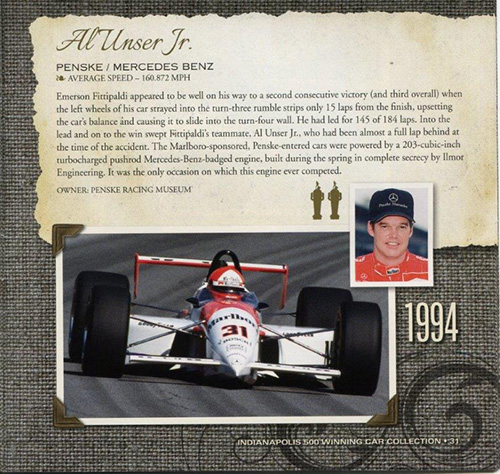
Front cover and part of the page from the catalog about the winners in 100 Years of the Indy 500 expo held in 2011 and a picture of PC23-007 as exposed. (Scans copyright & courtesy IMS Museum, photo HG)
Three years later, the Museum started with a series of less 'at large' exhibition themes and two of these themes made PC23-007 a candidate for appearing yet again at the IMS Museum - and such did indeed happen.
The first one was the “Team Penske 50th Anniversary” exhibition held in 2016. One of the Presentation examples of the Ilmor 265E was put next to the car
.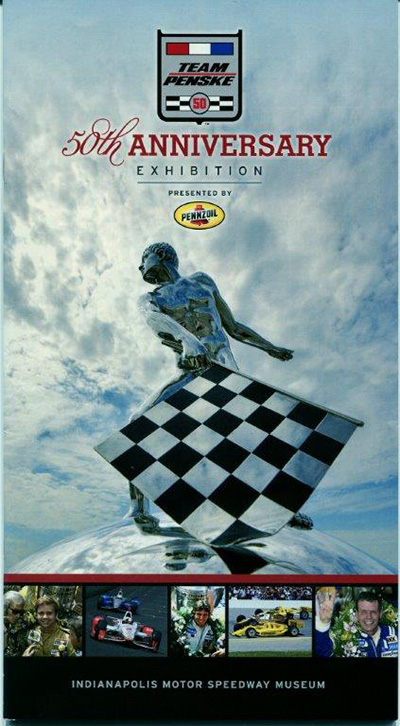
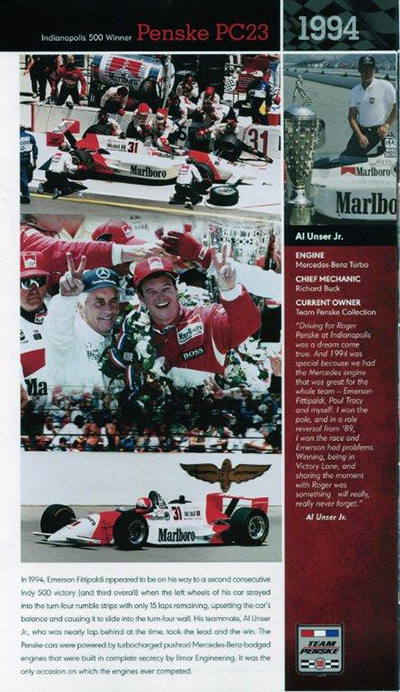
Front cover and page from the catalog about “50 years of Team Penske at Indy” expo held in 2016 and a picture of PC23-007 as exhibited there. (Scans copyright & courtesy IMS Museum, photo HG)
Then, in 2018, the car returned yet again to the Museum, this time to take part in the expo about the Unser family (Bobby, Al Sr and Al Jr) which, among others, featured just about all of the winning cars driven by the family.
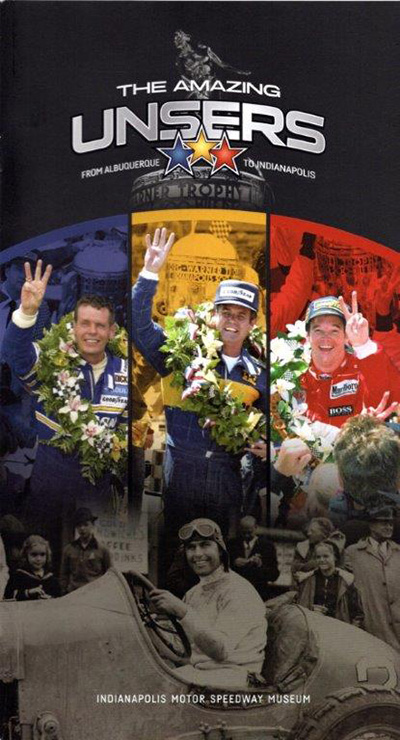
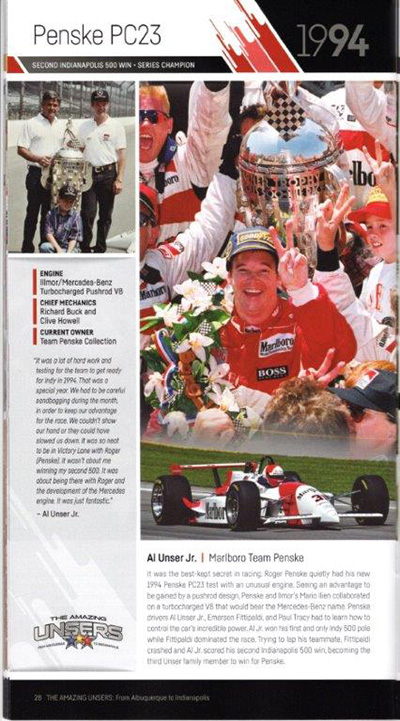
Front cover and page from the catalog about “The Unsers at Indy” exhibition held in 2018. A picture of PC23-007 as exhitibed has yet to follow. (scans copyright & courtesy IMS Museum, with special thanks to Walt Schaub, photo HG)
So one could say that for PC23-007 and the Speedway Museum there is something between them that resembles a LAT relationship. Or maybe another line is more appropriate, and I need to explain the background of that line first.
In the final stages of World War 2 a group of young Dutch pilots served on an British aircraft carrier in the Mediterranean. One after another, each of them had their own scary moment, all narrowly surviving or believed to be lost in action. But eventually, sooner or later, all of them returned in good health, sometimes against all odds, to continue service again.
Eventually, the story goes that their foreign mates on board of the carrier composed a little song they sang every time a party was organised to celebrate the return of the next Dutchie that had gone missing. The song contains the following lines:
“From the flying Dutchies you can learn
a ropy penny will always return”
In the past years, PC23-007 appears to have been a ropy penny for the IMS Museum… Hopefully to remain such for many more years and occasions.
PS: For the record…
If PC23-007 is a ropy penny for IMS Museum, it is one of three such pennies. Curiously enough there are two other cars that have returned to IMS to appear in the three very same exhibitions that also starred PC23-007. Al Jr’s dad Al Sr. and his uncle Bobby also won a race driving for Team Penske, and so Bobby’s ’81 winner and Al Sr’s ’87 winner also made it into the very same exhibitions. For Bobby’s winning car, however, it might be a bit less logical to have appeared in the “50 Years of Team Penske” exhibition since that car isn’t owned by the Penske organisation any longer but in private hands.
Another odd statistic these three winning cars of the Unser family share is the following: all the Unsers were multiple Indy winners, all of them won one of their victories driving for Team Penske. But for all of the Unsers, it was also their final “500” victory…
